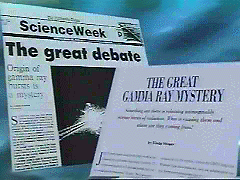Models of Gamma-ray bursts

On the theoretical side, it was once strongly believed that
neutron stars
within the Milky Way
were the sources of the
gamma-ray bursts. But
data from recent missions like
CGRO have caused many
of the supporting arguments for this idea to be proven wrong. The matter is one
of the most interesting, and unresolved, debates in high-energy
astrophysics
today.
 Show me a movie about the models being debated!
Show me a movie about the models being debated!
A theoretical understanding of gamma-ray bursts will comprise several
components: a site, an energy source, and an emission mechanism. The sites
must be consistent with the observed isotropy and inhomogeneity, the energy
source must be sufficient to produce the observed intensities for the distances
assumed, and the emission mechanism must be able to reproduce the time scales
and the spectra observed in bursts. Satisfying even these minimal observational
prerequisites has proved difficult. There have been over a hundred theoretical
papers proposing a wide range of scenarios for gamma-ray bursts. None have
provided complete details specifying the site, the energy source, and an
analysis of the energy emission processes.
Are the sources of Gamma-Ray Bursts in our Galaxy?
The particular Galactic model that
some scientists are now studying is motivated by the recent discovery that many
neutron stars are born with a higher velocity than previously thought (>500
km/s rather than <200 km/s). This would allow them to escape from the disk
and move into a
halo or corona
around the Galaxy at a distance of about 100
kpc. This distant corona contains an ample population of sources which appear
isotropic when viewed from Earth, and can therefore easily account for the
angular and brightness distributions of the BATSE bursts. The Galactic corona
model has the attractive feature that it can easily explain rapid time
variability, cyclotron lines, repetition, and the lack of bright
optical
counterparts.
Are the sources of GRBs outside our Galaxy?
Recent observations of apparent counterparts in other parts of the
electromagnetic spectrum seem to imply that at least some, if not all, GRB
occur in galaxies other than the Milky Way.
The observed isotropy is also a necessary requirement of cosmological models.
The apparent inhomogeneity would result from
redshift effects,
and possibly source evolution. If gamma-ray bursts are cosmological,
however, their
energy release must be gigantic. For the brightest bursts, if the intrinsic
emission is isotropic the total energy in gamma-rays must be 1053
to 1054 ergs, which is at least as great as that produced in
supernovae. The
difference, of course, is that in supernovae only 1051 ergs comes
out in kinetic energy and
visible light, and
almost all of the photons are well below
X-ray energies.
Cosmological models are being developed which can get all
that energy into high-energy photons; they are currently favored
by the majority of astrophysicists.
|
